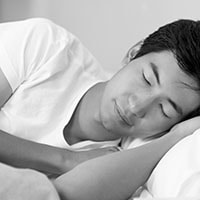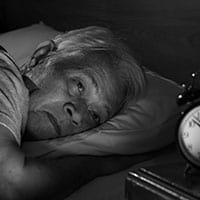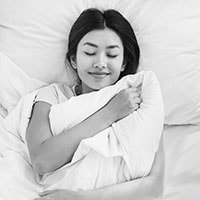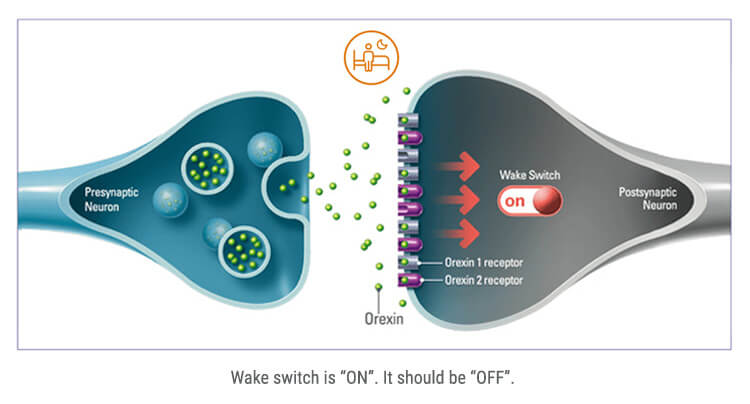The Role of Orexins In Sleep-Wake Regulation1
Rethinking the treatment of insomnia
Excessive wakefulness is common underlying cause of insomnia
NORMAL SLEEP-AWAKE REGULATION

Daytime
In the daytime,
orexins help us
stay awake

Night
At night,
orexin activity is very low
letting us sleep
INSOMNIA

Insomnia
In insomnia,
excess orexins prevent
us from sleeping

DAYVIGO
DAYVIGO blocks
orexin activity, helping
patients fall asleep
and stay asleep
Normal sleep-wake regulation occurs when the wake-promoting pathway predominates during the day, and the sleep-promoting pathway predominates at night.
In insomnia, patients have difficulty falling asleep or staying asleep as a result of an imbalance and conflict between these two pathways.
These pathways are controlled by wake-promoting and sleep-promoting neurotransmitters. The orexin neuropeptide signaling system is thought to play a critical role in wakefulness in the brain.2
What is DAYVIGO®
- A dual orexin receptor antagonist (DORA). The Orexin neuropeptide
signaling system is a central promoter of wakefulness.3 - Blocking the binding of wake-promoting neuropeptides orexin A and
orexin B to receptors OX1R and OX2R is thought to suppress wake drive.4
DAYVIGO works differently from sedatives which enhance sleep-promoting
effects through increased GABA activity2
DAYVIGO® blocks orexin activity at night, encouraging normal sleep
DAYVIGO prevents orexins from keeping the "wake switch" on.
• DAYVIGO suppresses wakefulness and can normalize sleep-wake patterns.


Set Patient Expectations5
Recommend an appropriate trial period
Your patients may feel differently when they fall asleep while taking DAYVIGO than their
previous experience or expectations
It's important to give DAYVIGO an appropriate trial period of 7 to 10 days as it may take
a few days to assess patient response
If insomnia persists after 7 to 10 days of treatment, reassess for comorbid conditions
Counsel your patients on good sleep hygiene
In addition to treatment, patients may benefit from improving their sleep
hygiene⎯habits that can help them optimize sleep. Some examples can include:
- Limit daytime napping
- Exercise
- Avoid foods that trigger indigestion
- Have a regular bedtime routine
- Ensure adequate exposure to natural light
- Establish a pleasant sleep environment
- Avoid stimulants (such as caffeine and nicotine) close to bedtime))
Effect of Food Lemborexant Cmax decreased by 23% AUC0-inf increased by 18%, and tmax was
delayed by 2 hours following administration of a high-fat and high-calorie meal.5
To download a patient information leaflet to provide to your patients after they been
prescribed DAYVIGO®, click here.
References:
-
Wang, Chunmei et al., 2018. The Orexin/Receptor System: Molecular Mechanism and Therapeutic Potential
for Neurological Diseases. Frontiers in molecular neuroscience, 11, p.220. -
Rosenberg, Russell et al., 2019. Comparison of Lemborexant With Placebo and Zolpidem Tartrate Extended Release for the
Treatment of Older Adults With Insomnia Disorder: A Phase 3 Randomized Clinical Trial. JAMA network open, 2(12), p.e1918254. -
Sakurai, Takeshi, 2007. The neural circuit of orexin (hypocretin): maintaining sleep and wakefulness.
Nature reviews. Neuroscience, 8(3), pp.171–181. -
Kärppä, Mikko et al., 2020. Long-term efficacy and tolerability of lemborexant compared with placebo in adults with insomnia
disorder: results from the phase 3 randomized clinical trial SUNRISE 2. Sleep (New York, N.Y.), 43(9), pp.Sleep (New York, N.Y.),
2020–09-14, Vol.43 (9). -
DAYVIGO (lemborexant) [Prescribing Information]. Eisai (HK) Co. Ltd; 2021.





